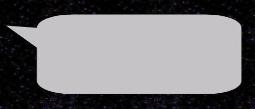| What is a circle? |
| Adapted for the Internet from: Why God Doesn't Exist |
1.0 Euclid's twirling baton
The circle has undergone significant modifications since the days of the Greeks without anyone noticing.
Euclid defined a circle (Fig. 1) as a twirling baton:
- “ a plane figure bounded by a continuous line called its circumference or periphery,
and having a certain point within it from which all straight lines are drawn to its
circumference are equal.” (Bk. I, Def. 15) [1]
Euclid used the crucial word continuous in the mathematical sense: between any two points there is
another one. Therefore, if his straight lines need to be drawn from the center to the circumference, they
must necessarily end on discrete points and not on a physically continuous curved line. Euclid’s alleged
circumference has no chance of being continuous. It is made of discrete beads one next to the other. The
physical notion of continuity requires that the circumference be made of a single piece and not of discrete
points. Therefore, his definition is an oxymoron.
However, we have to concede that Euclid did call his contraption a figure and justified it by using the crucial
word 'bounded' in his definition.
2.0 The ring of apples AND the orbiting bead of Mathematical Physics
The mathematicians have modified Euclid’s original definition significantly. A circle no longer consists of a
bunch of lines that converge upon a center. In fact, it doesn't even consist of the center or of any part
enclosed by the circumference. The circle of Mathematics can be either of two irreconcilable notions. The
mathematicians use both notions in the same dissertation and get away with the best of all worlds.
- a. a ring of apples (Fig. 2)
“ The set of points whose distance to a fixed point (the center) is a fixed positive
number (the radius) is a circle.” [2]
In order to know where to draw the next dot, you must plug in numbers into the computer, which
calculates the location according to the equation:
(x-x )²+(y-y )²=r²
In other words, the computer calculates ONE location at a time, which means that you are allowed to
place a single apple at a time. You are not permitted to see the circle of Mathematical Physics in a still
image. The 'circle' of Mathematics is NOT a geometric 'figure.' The circle of Math is a series of apples
that form a perimeter around absolutely nothing: The famous 'center' of the circle which is invoked to
define the this geometric 'figure' is NOT a part of the circle! Only the equidistant 'points' are part of the
alleged 'circle.'
b. an apple that orbits around you (Fig. 3).
“ A circle is the set of points in a plane that are equidistant from a given point O…
The angle a circle subtends from its center is a full angle, equal to 360° or 2π
radians.” [3]
Recall that the magnitude of an angle is the 'degree of rotation.' This is the only notion of angle that
has any practical use in Mathematics. The mathematicians have no use for the genuine, static angle
of Physics (i.e. 'two lines extending'). Indeed, the mathematicians are so sloppy with their definitions
and so inattentive to detail that sometimes they lose the apple altogether and continue to swing just
the string around themselves. The Wolfram site depicts a twirling radius.
But it only gets worse. Actually, it is not an apple swinging around a center, but an abstract location
swinging around another abstract location called the center! The alleged 'point' that the
mathematicians talk about is a dimensionless, static concept which the pictorial 'dot' is supposed to
represent. Later, the mathematicians confuse the dot for the location, blend the dots into a physically
continuous ring, and call it a circle.
So? What should we conclude? Is a circle a bunch of lines extending from a center, a ring of apples lying
still at the same distance from a center, or a single apple (or location) swinging around your head? Is a circle
enclosed by a fence or by an itinerary? Is the enclosed area of the circle a part of it? Does the center point
belong to the circle?
In Mathematics anything goes. Anyone says anything and everyone else just nods. That’s how the idiots of
Mathematics end up molding circles to the surface of spheres and saying that π is a variable.
Fig. 1 Euclid’s ‘twirling baton circle (a photograph: lines extending from a center) |
Fig. 2 The circle relativists advertised (a photograph: points equidistant from a center) |
Fig. 3 The relativistic circle that you got in the mail (a movie: a single apple swinging around an apple located in the center) |
3.0 The circle of Physics
In Physics, it is not even half as complicated as all of this. In Physics, we don’t define circles or triangles,
or, for that matter, any geometric figure. We point to a circle and say the word circle (Fig. 4). The ET now
visualizes what we are referring to and identifies the word with the indicated image for the rest of the
presentation. End of story!
Fig. 4 Circle |
Now, whether the mathematicians can use this object or not is irrelevant. This is what a circle is! This is a
geometric figure!
4.0 Conclusions
To summarize, for the purposes of Physics, a plane is a category of objects. More specifically, it includes
the ‘set’ of two-dimensional objects (e.g., triangles, squares, circles, pentagons, parallelograms, ellipses,
ovals, etc.). These figures:
- 1. do not stand alone, but are the faces of three-dimensional objects: the solids
2. are not infinite in extension, but rather have boundaries
3. are not made of points or lines, but are rather continuous and smooth – they are
- made of a single piece
But here’s the punch line, and you will hate me for this. I have analyzed points, lines, and planes for the
last few pages only to tell you that they are for the most part irrelevant in Physics. We don’t need any of
these categories to explain any important phenomenon of nature. These worthless figures are needed
only in the religion of Mathematical Physics. In Physics, we deal solely with solids.



But aren't you guys just
going around in circles?
going around in circles?

| Yeah, Bill! You're missing the point! This is how we make circles in Mathematical Physics. |




- Module main page: The 3-D planes of Mathematics
Pages in this module:
- 1. What is a plane?
2. Is a plane the same as a surface?
3. What does an infinite triangle look like?
4. Rough planes
5. How do you tilt a square?
6. What is a triangle?
7. This page: What is a circle?
o
o
- ________________________________________________________________________________________
- Copyright © by Nila Gaede 2008
